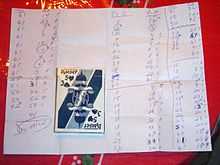Kaiser (card game)
 Typical score sheet from a game of Kaiser. | |
| Origin | Canadian Prairies |
|---|---|
| Alternative name(s) | Three-Spot |
| Type | Trick-taking |
| Players | 4 |
| Skill(s) required | Memory, Tactics, Communication |
| Cards | 32 |
| Deck | French |
| Play | Clockwise |
| Card rank (highest to lowest) | A K Q J 10 9 8 7 5 3 |
| Random chance | Medium |
| Related games | |
| Euchre | |
Kaiser, or three-spot, is a trick-taking card game popular in the prairie provinces in Canada, especially Saskatchewan and parts of its neighbouring provinces. It is played with four players in two partnerships with a 32-card deck.
Origins
The origins of this game are a mystery and there seems to be no historical record (spoken or written) that justifies it being a solely Saskatchewan-area game. It is especially popular among Ukrainian communities, and was possibly brought to Canada by Ukrainian immigrants, although it is not now played in Ukraine.
Kaiser means "emperor", the ruler of Germany from 1871 to 1918. During the Second World War a game referred to as troika (Russian troĭka, from troe "three"; akin to Old English thrīe "three") and the English version, three-spot, was played by war veterans in particular. These games were known for their bidding and trumping and the three in particular. The highest bid in these games was called a kaiser bid (12 notrump). It is because of this that it was referred to as that “kaiser bidding game” and eventually just that kaiser game.
Dealing
Kaiser is played by four people: two teams of two players each. Unlike many card games, only 32 cards are used out of a normal 52-card deck. The deck contains the cards from eight to ace inclusively (8, 9, 10, jack, queen, king, ace) for each suit. The other four cards are the seven of clubs, seven of diamonds, five of hearts and three of spades. All 32 cards are dealt out: eight to each player. The cards may be dealt in any order to any player at so long as each player ends up with eight cards.
Rule variations
Even though kaiser is a rare game, rules do vary between groups and between regions. Some variations on the popular rules include:
- Varying the minimum bid (usually anywhere from five to eight)
- Including the seven of hearts and seven of spades. When dealing, two cards are dealt into a "kitty" and the winning bidder may pick this kitty up and exchange cards in his or her hand for cards in the kitty. If the three or five are in the kitty, then the player must include these in his or her playing hand.
- Allowing passing between players. Players are allowed to pass one or two cards before bidding. This can create an opportunity for communication between players within the rules of the game. This is often accompanied by raising the minimum bid, because the increased level of strategy makes it possible to attain higher scores. This version is played in Wolseley, Saskatchewan.
- After winning the bid in notrump, the player has an option of playing the hand high or low. In high the play is normal. In low the strength of the cards are reversed while the five of hearts and the three of spades are neutral (for example in "low" play a seven would take a trick over an eight). This version is played in Canora, Saskatchewan.
References
- McLeod, John, ed., Kaiser, Card Games Website